At a glance
Expert’s Rating
Pros
- Very inexpensive
- Smooth hardware operation
- Lots of user management options
Cons
- Very rocky physical setup
- Limited advanced setting options
- Scanners (especially the fingerprint scanner) aren’t the best
Our Verdict
Price When Reviewed
This value will show the geolocated pricing text for product undefined
Best Pricing Today
Best Prices Today: Desloc D110 Plus
The market is rife with smart locks that cost $200, $300, and more—but if you look to the lower end, less than $100—your choices get sketchy, fast. Equipped with a fingerprint reader, NFC support, and integrated Wi-Fi, the $90 Desloc D110 Plus looks good on paper.
Unfortunately, some clear compromises to hit that price point prevent us from offering a wholehearted recommendation for the device.
A small monochrome display on the exterior escutcheon displays information such as battery life and Wi-Fi status.
Specifications
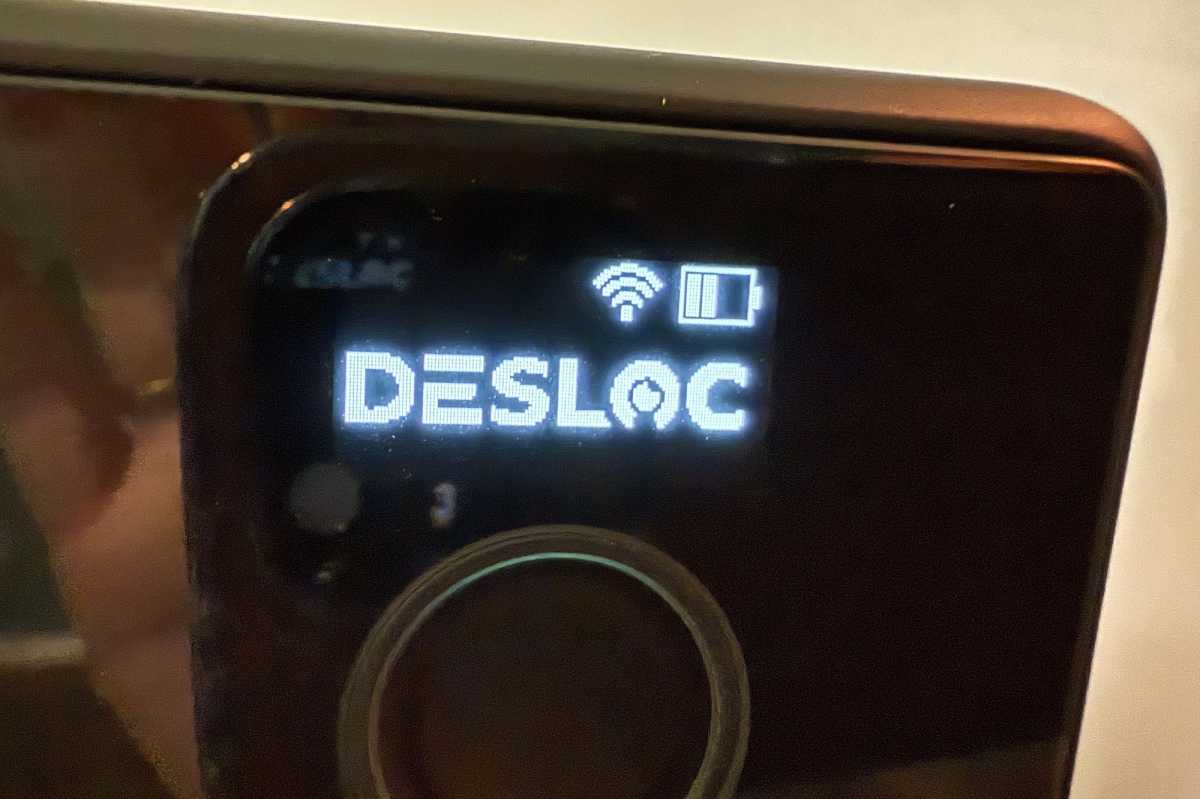
It seems like this display would be more useful on the inside of the door, unless the manufacturer’s objective is marketing.
Christopher Null/Foundry
This is a traditional Wi-Fi (2.4GHz only) smart lock featuring a touchscreen with a numeric keypad, a fingerprint reader, a physical keyhole (two keys included), and an NFC reader (with two tags included), giving users ample options when it comes to interacting with the lock.
Available in black or silver finishes, the lock measures about 6 by 3 inches both inside and outside the house and is made from a mix of aluminum and plastic. The lock carries a rather tame IP54 weatherproofing rating (our IP code guide tells us it can keep out enough particulate matter to prevent failure, and it can withstand being sprayed with a garden hose.
It’s certified ANSI/BHMA Level 3, which is the lowest acceptable level for commercial (not residential) locks. Kudos to Desloc for pursuing BHMA certification, not every lock in this price range does. (Don’t miss our guide to ANSI/BHMA certification.)
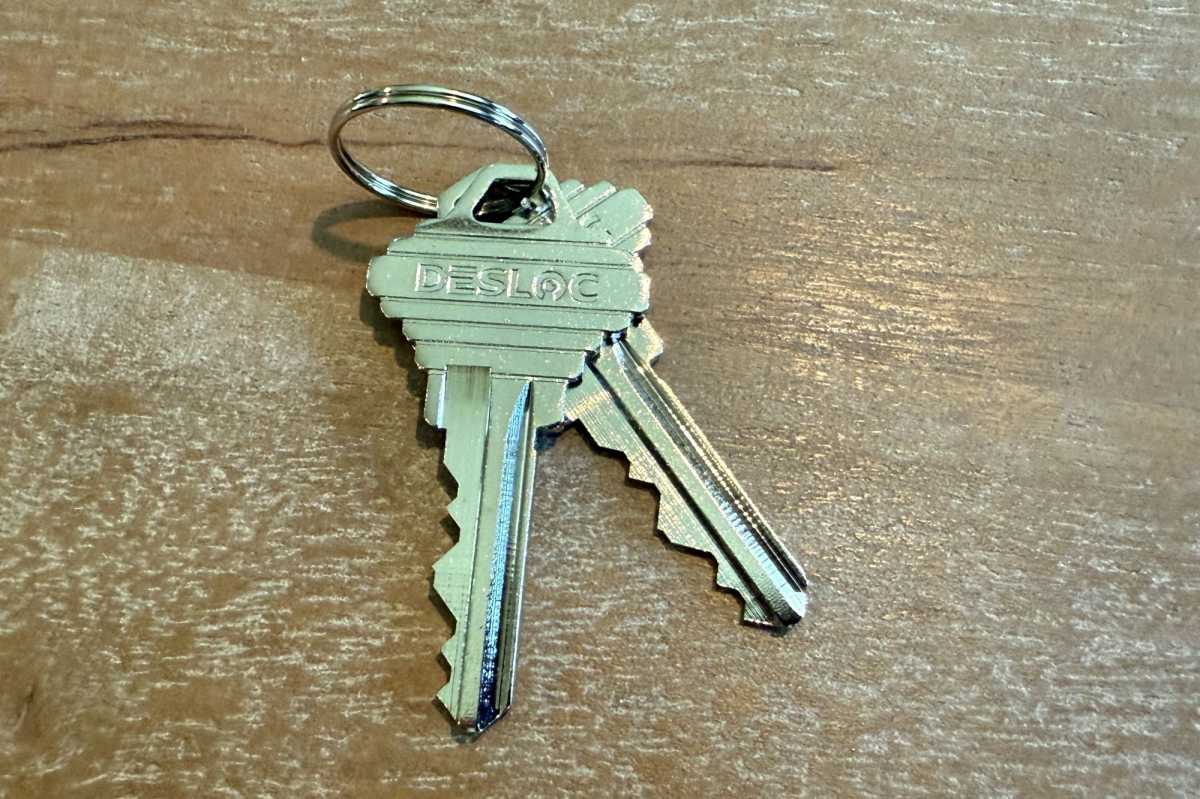
The Desloc D110 Plus comes with a set of good ol’-fashioned keys.
Christopher Null/Foundry
The lock is powered by four AA batteries (not included), which Desloc says will last for up to 6 months “with smart power optimization.” A USB-C port on the bottom of the exterior escutcheon is available for emergency power if the batteries die while you’re out. The device can support up to 100 PINs (with each one up to 8 digits in length) and 50 fingerprints.
One curious addition to this lock is the inclusion of a small monochrome display on the exterior escutcheon that displays information such as battery life and Wi-Fi status as well as simple messages like “Fail” if an invalid PIN is input.
While the lock is designed primarily for use with the Desloc mobile app, it also has support for Amazon Echo and Google Nest smart speakers and displays.
Installation and setup
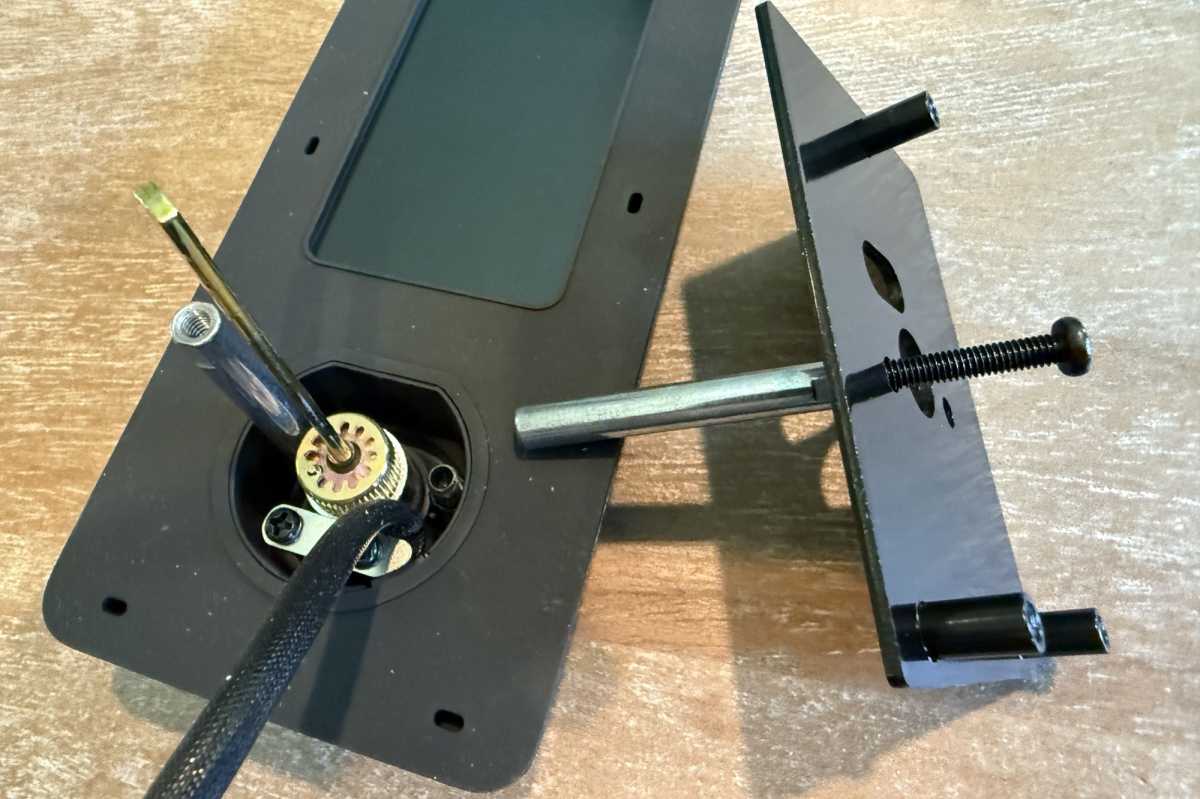
While standard in design, the Desloc D110 Plus physically came apart during our attempts to install it.
Christopher Null/Foundry
As with all complete smart locks (versus retrofit locks), installation begins with removal of your old lock, followed by attaching the Desloc 110 Plus’s exterior escutcheon to a frame that sits inside the door. Two long bolts are included for this, connecting to lengthy standoffs that jut out of the back of the exterior escutcheon and push through the deadbolt mechanism. Normally, getting these two bolts into place is a simple matter and one which I’ve done on other smart locks dozens and dozens of times. But when I tried to connect these bolts, they jammed, stopping about half an inch short of where they needed to be to firmly sandwich everything into place.
I normally use a low-power electric screwdriver for this work—most vendors actually instruct you not to use power tools on smart lock installation to avoid stripping the screws or damaging the equipment—but it choked every time I backed the bolts out and tried reseating them. Making matters worse, the bolt was wedged in so tightly that one of the standoffs on the exterior escutcheon designed to receive the bolt detached from the lock when I reversed the screwdriver, leaving me with a bit of a mess on my hands. (See photo for what I’m talking about.)
I asked Desloc about this and was surprised to hear that this is by design. The bolts are apparently supposed to be tight, and Desloc suggested using “something like an electric screwdriver with torque” to push past the blockage. This went against everything instinct I have, and sure enough, one second with a more powerful screwdriver promptly began to strip the screwheads. I eventually gave up and simply muscled the bolts in with a manual screwdriver, being careful not to further strip the heads.
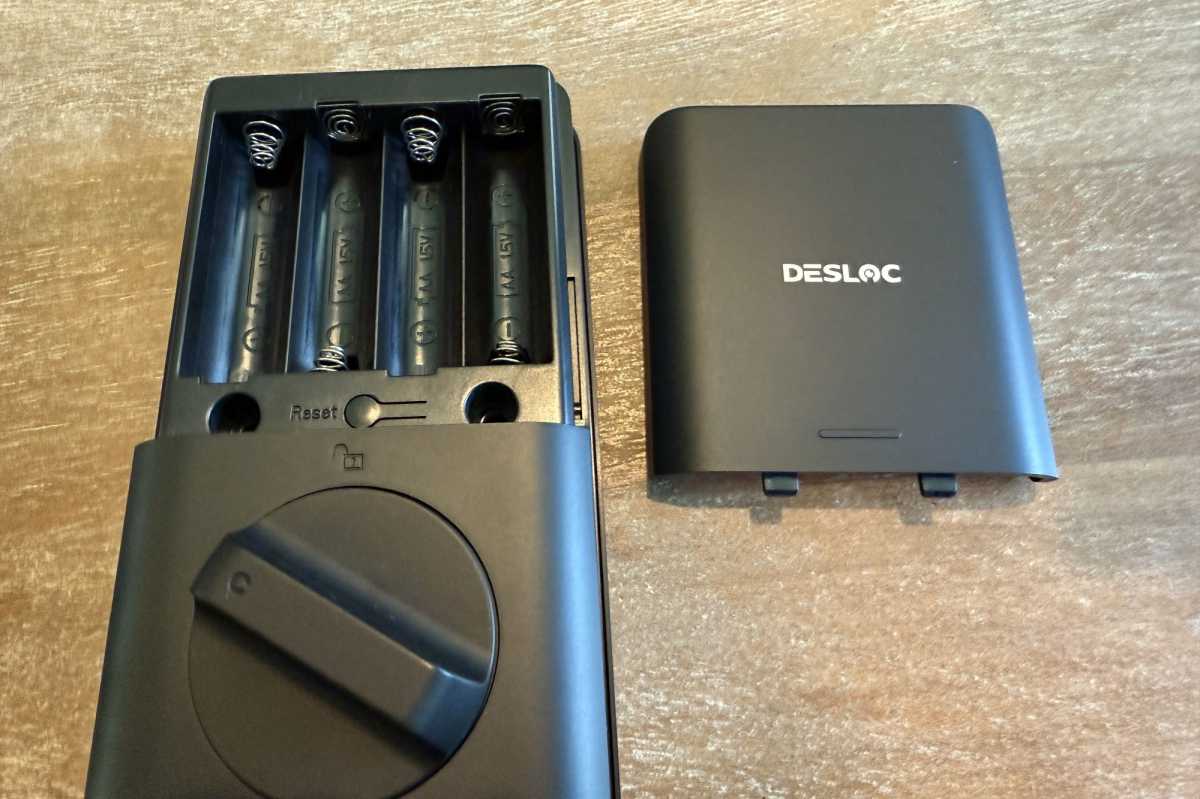
The Desloc D110 Plus runs on 4 AA batteries, but you’ll need to supply them.
Christopher Null/Foundry
With the plate in place, the interior escutcheon attaches to a single electrical cable and uses three smaller bolts—which are also quite stiff—to hang on to the plate. With four batteries in place, I was then able to use the Desloc app to auto-discover the lock and complete onboarding and Wi-Fi bridging via a Bluetooth connection. One nice feature: The lock automatically calibrates whether it is on a left- or right-hand door during initial setup.
Using the Desloc D110 Plus
For such a simple lock, the Desloc D110 Plus has plenty of features, and for the most part they work well, but not great. The app is simple to manage, letting you specify users as “Always,” “Schedule” (time restricted), or “One-Pass” (for one-time codes, which expire in about 2 hours). “Always” users can be configured with multiple PINs, fingerprints, and NFC cards, while users on a schedule can only be configured with PIN access. Schedules can be set with a single deadline or with recurring access based on time and day of the week.
The Desloc app logs everything—locks and unlocks alike—and it can be set to send notifications for all types of activity, although it doesn’t log failed attempts to open the lock unless the wrong-try protection lockout is activated. There’s no way to adjust the lockout feature, however, or any explanation of how it works. Simply scanning the admin fingerprint removes the lockout error.
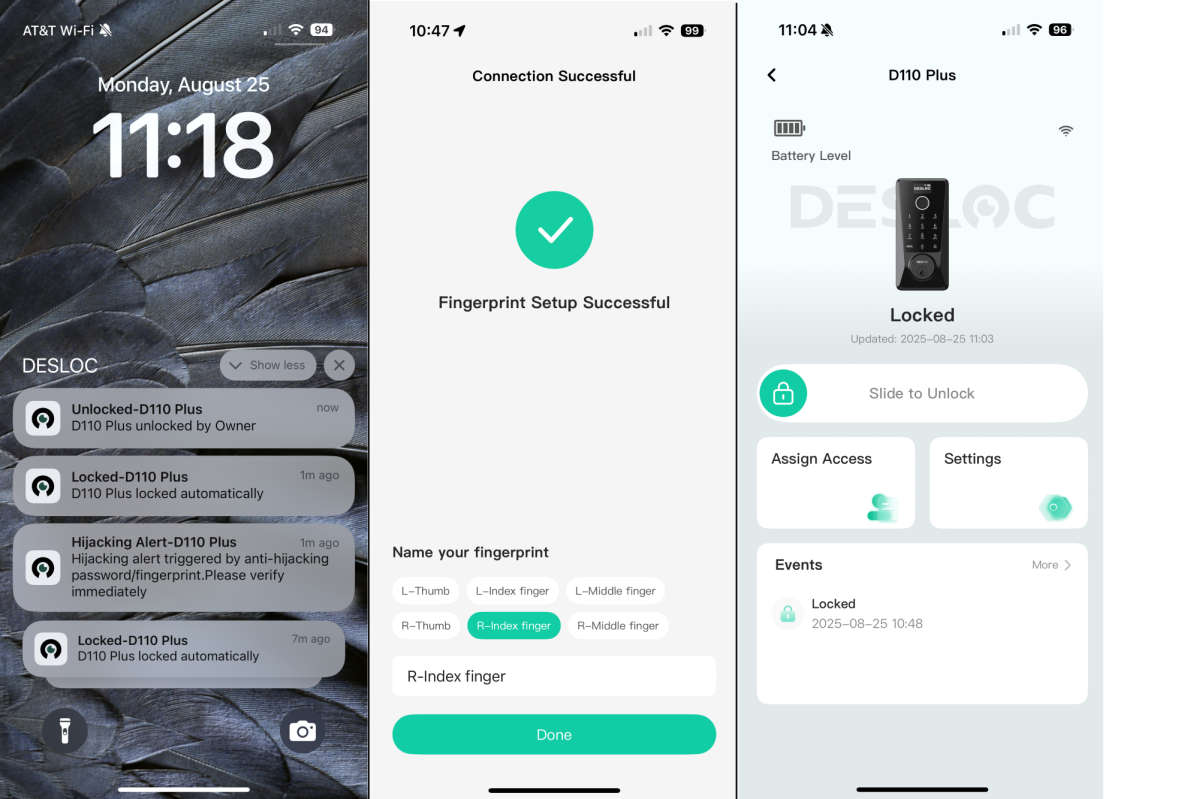
Basic configuration and control options are placed front and center in the app. You’ll receive push notifications for the typical events.
Christopher Null/Foundry
Auto-locking can be configured to kick in after 5 to 120 seconds, although it bizarrely can’t be turned off on this screen. That’s something of a problem because the auto-lock engages whether the door is open or closed. (You can disable auto-locking altogether by activating Passage Mode, but that is not exactly the intended function of this feature.) Closing the door with the bolt extended—or if the wind blows it closed—risks damage to the trim around your doorframe.
One interesting addition in the app is the option to set anti-hijacking PINs and/or fingerprints. These are credentials that will open the lock, but that which send an SOS alert to an emergency email address of your choice. This worked fine in my testing, but all the alert emails went to my spam folder. Push notifications would be much more useful.
From a hardware perspective, the D110 Plus is best described as working “just OK.” The keypad is slow to wake up and can require many taps to get it to engage. The fingerprint reader was hit-and-miss in my testing, often requiring multiple scans. And the NFC card reader usually required rubbing the card all over the front of the lock to find the sweet spot to get it to activate. Fortunately, the lock is physically smooth in operation and reasonably quiet; I never encountered any jamming during several days of testing.
Should you buy the Desloc D110 Plus?
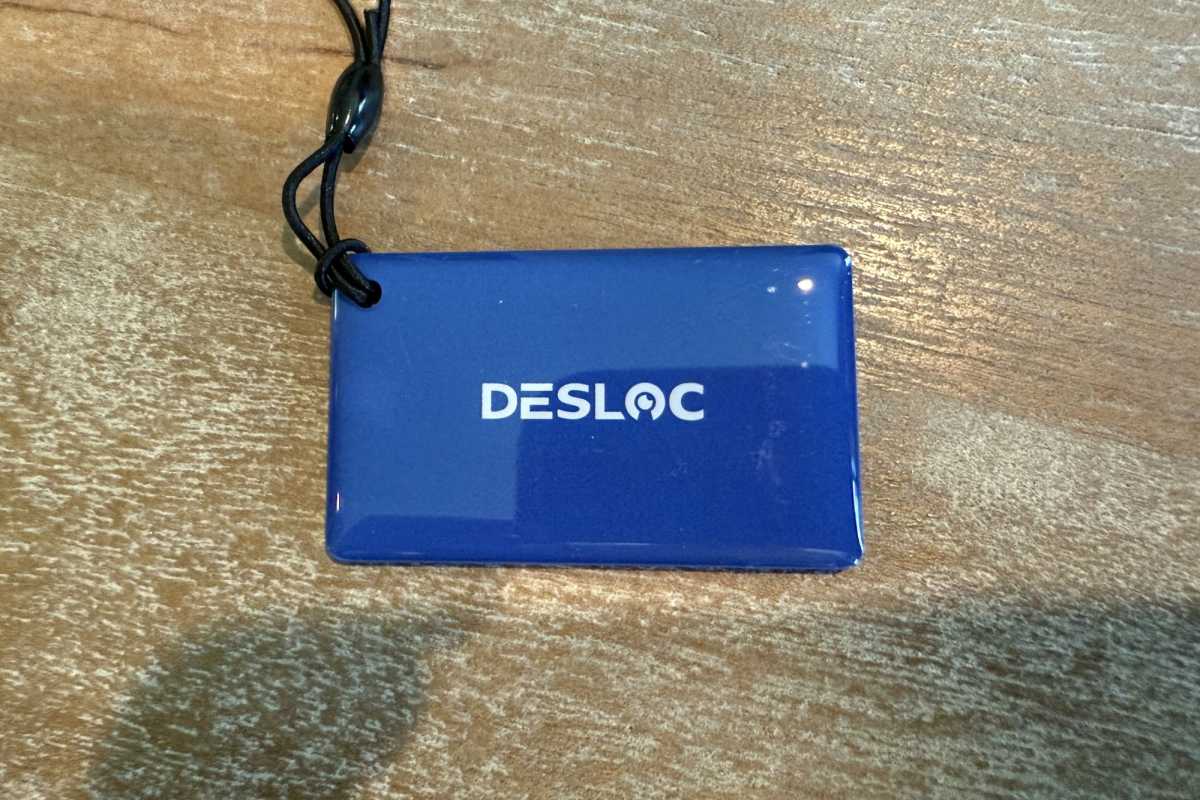
NFC cards–two are supplied–provide an alternative to a PIN, fingerprint, or keys for unlocking the Desloc D110 Plus.
Christopher Null/Foundry
The Desloc D110 Plus is clearly a value-oriented product, and it shows throughout. The construction quality is questionable, scanning quality is so-so, and the lack of any advanced features make the system feel like the budget offering it is.
That said, it works well enough if you have a rock-bottom budget to invest in a smart lock (you might want to check out the $70 Tapo DL100 before you pull the trigger, although it has fewer features).
On the other hand, lock hardware is generally the last place I recommend smart home users look for savings.
This review is part of TechHive’s in-depth coverage of the best smart locks.















